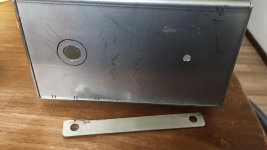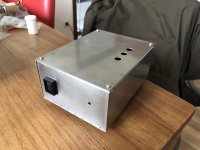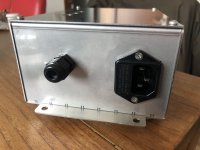How would you make this when you don't have access to a tool shop? Do you think
its possible to make it visually nice with just a file, angle grinder and sandpaper?
The ss material is way too hard for hand work for even thin pieces, much less for baffle thick.
Use a thin dress piece in front of a regular baffle. A machine shop with laser cutting
can easily do this cheaply, for a thin piece.
Last edited:
It can be done on a press brake, the machines used for sheet metal bending, up to 1/8 inch thickness.
6 mm is way too thick, and will have resonance problems.
Basically you will be removing about 30% of the material, by hand.
This is off hand, I did not work it out, don't hold me to it.
Way too much work, and think about 4 hours per piece, grinding by hand.
Too much hassle, and the result will be bad acoustically.
6 mm is way too thick, and will have resonance problems.
Basically you will be removing about 30% of the material, by hand.
This is off hand, I did not work it out, don't hold me to it.
Way too much work, and think about 4 hours per piece, grinding by hand.
Too much hassle, and the result will be bad acoustically.
How would you make this when you don't have access to a tool shop? Do you think its possible to make it visually nice with just a file, angle grinder and sandpaper? What tools would you choose to do it?
Possible? Sure, but here's where it fits on H713's list of miserable tasks (with 1 being the worst):
1) Cleaning 10-year-old tape goo off of irreplaceable equipment
2) Re-coring a 40-year-old neglected boat for a "friend"
2) Cheerleading
3) This project
4) Grooming a cranky, matted tiger
5) Dealing with university management
6) Remodeling a 1970s bathroom
7) Chipping ice off the sidewalk during the polar vortex
Even with a machine shop, this is a highly unpleasant task that I wouldn't want to do. I've spent plenty of time machining stainless. Trust me, if you don't have the right tooling, find someone who does. You can "make do" with aluminum or mild steel, but when it comes to stainless, you really need the right cutters and machines.
It depends on how much work you're willing to do.
I wouldn't trust any handtools that works quickly, like angle-grinder. Maybe use diamond coated files, but it will still take some time. Or you could possibly drop it of at a machineshop and have them do the bulkload of the work.
I wouldn't trust any handtools that works quickly, like angle-grinder. Maybe use diamond coated files, but it will still take some time. Or you could possibly drop it of at a machineshop and have them do the bulkload of the work.
Piece of cake, just get a flap disc for your angle grinder, start of with a 45 deg bevel, then take the edges off to blend it in. If you're really keen make a block of wood with the correct internal radius, stick some emery ( or alloy oxide ) cloth on and rub it up and down to get a continuous profile. Some hi-fin polish on a mop ( I use an 8 inch dia on a 3 Kw 2,800 rpm 3 ph induction motor, but this is at work ), will bring it up like chrome.
It used to be considered good practice to use a file on brass/bronze etc first, then when it's slightly worn use it on steel, a file used on steel will skate over brass. I sometimes use emery cloth over a file, but perhaps that says more about the state of the files at work.
Piece of cake, just get a flap disc for your angle grinder, start of with a 45 deg bevel, then take the edges off to blend it in. If you're really keen make a block of wood with the correct internal radius, stick some emery ( or alloy oxide ) cloth on and rub it up and down to get a continuous profile. Some hi-fin polish on a mop ( I use an 8 inch dia on a 3 Kw 2,800 rpm 3 ph induction motor, but this is at work ), will bring it up like chrome.
okay nice. so when using an angle grinder it shouldn't be a problem. I will take my time and work slowly to don't ruin it by mistake
I had to make a S/S fascia plate for a really old safe I was working on. The manufacturer could not supply a new fascia so I made one out of 4mm S/S.
I used an angle grinder to cut the plate and a bench sander to flatten the edges and square up the plate.
The edges were quite sharp so I rounded them to a smooth radius with a bench sander.
That would be how I would make the radius you are looking for. A belt sander would do the same job and probably be faster than a flap wheel.
Id be more concerned about how you are going to cut out the speaker holes you need because stainless will work harden once you start cutting/drilling into it. And 6mm will be a biatch to cut a nice neat hole. Even with a milling machine the fascia was not easy to cut and took 20 or so minutes using 6 different sized drills to make a measly 20mm hole.
I used an angle grinder to cut the plate and a bench sander to flatten the edges and square up the plate.
The edges were quite sharp so I rounded them to a smooth radius with a bench sander.
That would be how I would make the radius you are looking for. A belt sander would do the same job and probably be faster than a flap wheel.
Id be more concerned about how you are going to cut out the speaker holes you need because stainless will work harden once you start cutting/drilling into it. And 6mm will be a biatch to cut a nice neat hole. Even with a milling machine the fascia was not easy to cut and took 20 or so minutes using 6 different sized drills to make a measly 20mm hole.
That is experience talking  Never again....many dull drills, a dull file, a dull saw and a casing that looks like coming from the Iron Curtain era...
Never again....many dull drills, a dull file, a dull saw and a casing that looks like coming from the Iron Curtain era...
As the round switches I had somehow did not look good in the casing I used a file to change the round hole to a rectangular one for the switch I use now. Elbow sweat!
As the round switches I had somehow did not look good in the casing I used a file to change the round hole to a rectangular one for the switch I use now. Elbow sweat!
Attachments
Last edited:
The technique for drilling stainless seems to be " go for it ", use a drill press ( or lathe ) and put a lot of pressure on to drill through the metal before it has a chance to work harden. And use the correct spead, to fast and you'll just blue the drill. I agree that a belt sander or linisher ( use a blue belt if you can ) would be better if you have access to one.
Go for it.
I've done a lot of work on stainless steel and it is challenging, but it's completely workable with the right techniques, even with simple tools.
Drilling: as was said, slow speed, lots of pressure. If you're not making chips, stop. Work-hardening is not a joke, I would add: SHARP split-point cobalt bits and some/any kind of lubrication. Also start small and work your way up to final size 2x at a time.
For the radius, what's been said above is right. Files dull quickly and are largely useless on stainless, but even the cheap diamond-grit ones can be useful to straighten out a wobbly line. Flap discs are great, and come in different grits. Start at 36 grit or so. Again 2x increase in grit # between steps.
Only problem with the disks is trying to get a nice straight line, not a wobbly one. If you have access to a small belt sander, I would get some zirconia (usually blue or purple) belts. Should be able to get a visually pleasing curve. Scotch-Brite disks can be good for final steps, although you may end up with some hand-sanding at the end.
I've done a lot of work on stainless steel and it is challenging, but it's completely workable with the right techniques, even with simple tools.
Drilling: as was said, slow speed, lots of pressure. If you're not making chips, stop. Work-hardening is not a joke, I would add: SHARP split-point cobalt bits and some/any kind of lubrication. Also start small and work your way up to final size 2x at a time.
For the radius, what's been said above is right. Files dull quickly and are largely useless on stainless, but even the cheap diamond-grit ones can be useful to straighten out a wobbly line. Flap discs are great, and come in different grits. Start at 36 grit or so. Again 2x increase in grit # between steps.
Only problem with the disks is trying to get a nice straight line, not a wobbly one. If you have access to a small belt sander, I would get some zirconia (usually blue or purple) belts. Should be able to get a visually pleasing curve. Scotch-Brite disks can be good for final steps, although you may end up with some hand-sanding at the end.
- Home
- Design & Build
- Construction Tips
- how to 3/4/5mm radius on 6mm stainless steel plate


